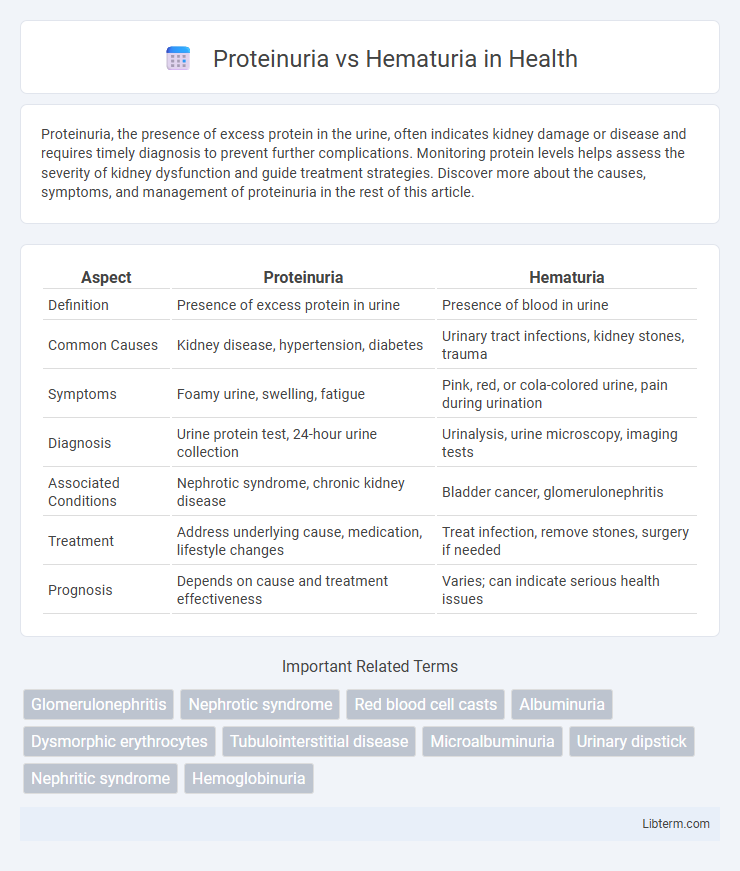Proteinuria, the presence of excess protein in the urine, often indicates kidney damage or disease and requires timely diagnosis to prevent further complications. Monitoring protein levels helps assess the severity of kidney dysfunction and guide treatment strategies. Discover more about the causes, symptoms, and management of proteinuria in the rest of this article.
Table of Comparison
| Aspect | Proteinuria | Hematuria |
|---|---|---|
| Definition | Presence of excess protein in urine | Presence of blood in urine |
| Common Causes | Kidney disease, hypertension, diabetes | Urinary tract infections, kidney stones, trauma |
| Symptoms | Foamy urine, swelling, fatigue | Pink, red, or cola-colored urine, pain during urination |
| Diagnosis | Urine protein test, 24-hour urine collection | Urinalysis, urine microscopy, imaging tests |
| Associated Conditions | Nephrotic syndrome, chronic kidney disease | Bladder cancer, glomerulonephritis |
| Treatment | Address underlying cause, medication, lifestyle changes | Treat infection, remove stones, surgery if needed |
| Prognosis | Depends on cause and treatment effectiveness | Varies; can indicate serious health issues |
Understanding Proteinuria and Hematuria
Proteinuria is characterized by the presence of excess protein in the urine, often indicating kidney damage or disease such as glomerulonephritis or diabetic nephropathy. Hematuria refers to the presence of blood in the urine, which can result from urinary tract infections, kidney stones, or malignancies in the urinary system. Both proteinuria and hematuria are critical diagnostic markers that require further evaluation through urinalysis, imaging, and sometimes biopsy to determine the underlying pathology and appropriate treatment.
Definitions: What is Proteinuria?
Proteinuria is the presence of an abnormal amount of protein in the urine, often indicating kidney damage or disease. It occurs when the kidneys' filtering units, called glomeruli, are impaired and allow protein to leak into the urine. Unlike hematuria, which involves blood cells in the urine, proteinuria specifically refers to excess protein excretion.
Definitions: What is Hematuria?
Hematuria is the presence of red blood cells in the urine, which can indicate underlying conditions such as urinary tract infections, kidney stones, or trauma to the urinary system. It is classified into two types: gross hematuria, where blood is visible to the naked eye, and microscopic hematuria, detected only through urine microscopy. Differentiating hematuria from proteinuria, which involves excess protein in urine, is crucial for accurate diagnosis and treatment.
Key Differences Between Proteinuria and Hematuria
Proteinuria refers to the presence of excess protein in the urine, indicating possible kidney damage or disease, while hematuria involves the presence of red blood cells in the urine, often signaling urinary tract infections, stones, or trauma. Proteinuria is typically detected through urine protein tests or dipstick analysis, whereas hematuria is identified via microscopic examination or gross visual detection of blood in urine. Both conditions require further diagnostic evaluation to determine underlying causes, but proteinuria primarily reflects glomerular injury, whereas hematuria suggests bleeding within the urinary tract.
Causes of Proteinuria
Proteinuria occurs primarily due to kidney conditions such as glomerulonephritis, diabetic nephropathy, and hypertensive nephrosclerosis, which increase the permeability of the glomerular filtration barrier. Other causes include transient factors like fever, intense physical exertion, and dehydration, as well as chronic diseases including multiple myeloma and lupus nephritis. In contrast, hematuria typically arises from urinary tract infections, kidney stones, or malignancies affecting the urinary tract.
Causes of Hematuria
Hematuria, the presence of blood in urine, often results from urinary tract infections, kidney stones, trauma, or malignancies within the urinary system. Glomerulonephritis and other kidney diseases can also cause hematuria by damaging the glomeruli, leading to red blood cell leakage. Identifying the underlying cause typically involves urinalysis, imaging studies, and sometimes cystoscopy to distinguish hematuria from proteinuria, which is characterized by excess proteins in urine.
Clinical Significance and Risks
Proteinuria indicates abnormal amounts of protein in the urine, often signaling kidney damage or disease such as glomerulonephritis or diabetic nephropathy, and serves as a critical marker for chronic kidney disease progression. Hematuria involves the presence of blood in the urine, potentially caused by urinary tract infections, kidney stones, or malignancies like bladder cancer, and requires thorough evaluation to identify underlying pathology. Both conditions demand prompt clinical assessment as persistent proteinuria and hematuria increase the risk of renal impairment, cardiovascular disease, and morbidity if left untreated.
Diagnostic Tests for Proteinuria vs Hematuria
Diagnostic tests for proteinuria primarily include a urinalysis to detect abnormal protein levels, followed by a 24-hour urine collection to quantify protein excretion. In contrast, hematuria diagnosis involves microscopic examination of urine for red blood cells, often supplemented by urine cytology and imaging studies such as ultrasound or CT scan to identify underlying causes. Both conditions may require kidney biopsy if initial tests are inconclusive or to assess kidney damage severity.
Treatment Approaches for Each Condition
Proteinuria treatment primarily targets the underlying cause, such as controlling diabetes or hypertension with ACE inhibitors or ARBs to reduce protein leakage in urine. Hematuria management depends on the source, including antibiotics for infections, surgery for structural abnormalities, or monitoring for malignancies. Both conditions require thorough diagnostic evaluation to tailor effective and specific therapeutic interventions.
Preventive Strategies and Patient Management
Proteinuria prevention centers on controlling underlying conditions such as diabetes and hypertension through lifestyle modifications, dietary sodium reduction, and use of ACE inhibitors or ARBs to reduce kidney damage. Hematuria management involves identifying and treating causative factors like urinary tract infections, stones, or malignancies, with preventive strategies emphasizing hydration, avoiding nephrotoxic agents, and regular screening in high-risk populations. Patient monitoring includes routine urinalysis, renal function assessment, and timely referral to nephrology or urology specialists for persistent or unexplained findings.
Proteinuria Infographic

 libterm.com
libterm.com